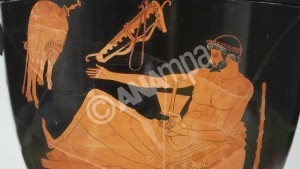Who was the Berlin Painter and why is he so interesting? An exhibition starting on March 4 at Princeton University attempts to shed light on the life and work of the most important and influential artists living in ancient Athens in early 5 BC.
The exhibition “the Berlin Painter and his World: Athens angiography in early 5 BC” is the title of the first big exhibition dedicated to the angiographer for whom we know almost nothing not even his name. However a plethora of his works, over 500 potteries speak for himself. 54 of his works will be at display along with works of other artists of the era as Phidias and Kleophrades.
The Berlin Painter who was named by Sir John Beazley for a large lidded amphora in the Antikensammlung Berlin (the Berlin Painter’s name vase), was a humble craftsman. We don’t know if he was a citizen of Athens, a slave or a settler, said the exhibition’s curator Dr. Michael Padgett to Athens Macedonian News Agency.
“His art was unique, the Painter of Berlin prefers to isolate each pattern which is depicted with style and precision on a black font with the minimun decoration, in some cases with no adorment at all. His style is exquisite and intellectual which is in total contract with his huge component Painter of Kleophrades,” underlined Dr. Padgett.
His career was long (505 -465 BC) and his works were found in several regions from Italy to Krimea and from Etruria to Libya on Rhodes and all the eastern Mediterrenean. Probably his name was not known outside Athens because he did not sign his works.
Approximately 30 vases or pottery fragments which are at display in Greek museums are attributed to the Berlin Painter including a wonderful lekythos depicting Nike that is in Benaki Museum in Athens, however most of his works found under the Parthenon on the Acropolis Hill are displayed at the National Archaeological Museum of Athens.
The exhibition will run until June 11 and afterwards it will travel to the Art Museum of Toledo, Ohio where it will run until October 1.
Ask me anything
Explore related questions





